英语介绍古典音乐、民族音乐
最新古典音乐介绍英文版

• Characterized by increased attention to an extended melodic line, as well as expressive and emotional elements, paralleling romanticism in other art forms
early music period
Baroque period
Medieval (500–1400)
&
(1600–1750)
Renaissance (1400–1600)
Classical period (1750–1830)
Romantic period (1815–1910)
Early music period
Common practice periodBarLeabharlann que era 1600–1750
Classical era 1750–1830
Romantic era 1815–1910
Baroque music
•Keyboard music played on the harpsichord and pipe organ became increasingly popular •Violin family of stringed instruments took the form generally seen today •Opera as a staged musical drama began to differentiate itself from earlier musical and dramatic forms •Vocal forms like the cantata and oratorio became more common
介绍中国古典乐曲英语作文

介绍中国古典乐曲英语作文China's classical music has a long history, dating back thousands of years. It is a rich and diverse art form that encompasses a wide range of styles and instruments.The most well-known Chinese classical music instrument is the guqin, a seven-stringed zither that has been played for over 3,000 years. Its haunting and ethereal sound has captivated audiences for centuries.Another popular instrument is the pipa, a four-stringed lute that is often used in traditional Chinese opera and folk music. Its bright and lively sound adds a uniqueflavor to Chinese classical music.In addition to these traditional instruments, Chinese classical music also features a wide range of percussion instruments, such as the guzheng, a type of zither, and the dizi, a bamboo flute. These instruments add depth and complexity to the music, creating a rich and vibrant sound.Chinese classical music is often characterized by its use of pentatonic scales, which give it a distinct and recognizable sound. The melodies are often lyrical and flowing, with a strong emphasis on harmony and balance.One of the most famous Chinese classical music pieces is "High Mountains and Flowing Water," a guqin composition that dates back to the Tang dynasty. Its evocative melody and elegant structure have made it a beloved classic in Chinese music history.Overall, Chinese classical music is a beautiful and expressive art form that reflects the rich cultural heritage of China. Its intricate melodies and unique instruments create a captivating and immersive listening experience for audiences around the world.。
英语介绍中国古典乐曲作文

Chinese classical music is an integral part of the rich tapestry of Chinese culture, with a history that spans thousands of years. It is characterized by its unique scales, instruments, and compositions that reflect the essence of traditional Chinese philosophy and aesthetics.One of the most distinctive features of Chinese classical music is its use of pentatonic scales, which consist of five notes per octave. This scale creates a unique sound that is both soothing and evocative, often associated with the natural world and the human emotions.The instruments used in Chinese classical music are as diverse as the music itself. Some of the most common instruments include the guqin, a sevenstringed zither known for its ethereal and contemplative sound the pipa, a fourstringed lute with a bright and expressive tone and the erhu, a twostringed fiddle that produces a haunting and emotional melody.Chinese classical music compositions often tell stories or evoke images of landscapes, legends, and historical events. For example, the famous piece High Mountain and Running River is said to depict the majestic scenery of mountains and flowing rivers, while The Moon Represents My Heart is a romantic ballad that expresses deep affection and longing.In addition to its artistic value, Chinese classical music also has a strong connection to traditional Chinese medicine and philosophy. It is believed that the different notes and scales can have a healing effect on the body and mind, and many people practice qigong or meditation while listening to this music.Overall, Chinese classical music is a treasure trove of cultural heritage that continues to captivate and inspire people around the world. Its timeless melodies, rich history, and profound spiritual significance make it a truly unique and valuable art form.。
英语介绍中国古典乐曲作文
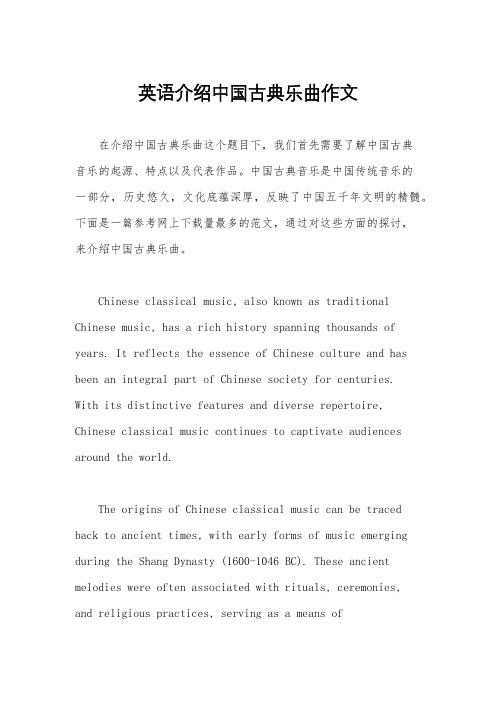
英语介绍中国古典乐曲作文在介绍中国古典乐曲这个题目下,我们首先需要了解中国古典音乐的起源、特点以及代表作品。
中国古典音乐是中国传统音乐的一部分,历史悠久,文化底蕴深厚,反映了中国五千年文明的精髓。
下面是一篇参考网上下载量最多的范文,通过对这些方面的探讨,来介绍中国古典乐曲。
Chinese classical music, also known as traditional Chinese music, has a rich history spanning thousands of years. It reflects the essence of Chinese culture and has been an integral part of Chinese society for centuries.With its distinctive features and diverse repertoire, Chinese classical music continues to captivate audiences around the world.The origins of Chinese classical music can be traced back to ancient times, with early forms of music emerging during the Shang Dynasty (1600-1046 BC). These ancient melodies were often associated with rituals, ceremonies,and religious practices, serving as a means ofcommunication with the divine. Over time, Chinese music evolved, incorporating elements from various dynasties and regions, resulting in a diverse range of styles and genres.One of the defining characteristics of Chineseclassical music is its emphasis on melody and expression. Unlike Western classical music, which often focuses on harmony and structure, Chinese music places greater importance on melodic variations, subtle nuances, and emotional depth. This emphasis on melody allows performersto convey a wide range of emotions, from joy andcelebration to sadness and introspection.Another distinctive feature of Chinese classical musicis its use of traditional instruments, many of which have been used for centuries. These instruments include the pipa, guqin, erhu, dizi, and guzheng, each with its unique sound and timbre. The pipa, for example, is a pear-shaped lutewith four strings, while the guqin is a seven-stringedzither known for its delicate tones. These instruments are often played together in ensembles, creating intricate harmonies and textures that are characteristic of Chinesemusic.Chinese classical music is also known for its rich repertoire of traditional melodies and compositions. These pieces often draw inspiration from nature, literature, poetry, and philosophical concepts, reflecting the cultural heritage and artistic sensibilities of the Chinese people. One of the most famous classical compositions is "High Mountains and Flowing Water," a guqin piece dating back to the Tang Dynasty (618-907 AD). This evocative melody depicts the majestic beauty of nature, with cascading notes and flowing rhythms that transport listeners to distant landscapes.In addition to its traditional repertoire, Chinese classical music has also undergone modernization and innovation in recent years. Contemporary composers and musicians have sought to preserve and revitalizetraditional music while also exploring new techniques and styles. This fusion of tradition and innovation has led to the emergence of new genres such as Chinese fusion, blending traditional instruments with modern elements suchas electronic music and jazz.In conclusion, Chinese classical music is a treasure trove of cultural heritage and artistic expression. With its rich history, distinctive features, and diverse repertoire, it continues to inspire and enchant audiences both in China and around the world. As we celebrate the legacy of Chinese classical music, we honor the enduring beauty and vitality of one of the world's oldest musical traditions.。
古典音乐英文介绍作文简单

古典音乐英文介绍作文简单Classical music, also known as Western classical music or art music, is a genre of music that originated in the traditions of Western culture, including liturgical (religious) and secular music. It encompasses a vast range of styles, periods, and forms, spanning from the medieval era to the present day. Here, we delve into the essence of classical music, exploring its rich history, defining characteristics, and enduring appeal.### Historical Overview:Classical music has its roots in the religious chants and secular songs of the medieval period. During the Renaissance (14th to 17th centuries), composers began to write polyphonic music, where multiple independent melody lines were woven together harmoniously. This era saw the emergence of renowned composers such as Giovanni Pierluigi da Palestrina and Josquin des Prez.The Baroque period (17th to early 18th centuries) witnessed the flourishing of intricate compositions characterized by ornamentation, elaborate forms, and dramatic expression. Prominent composers of this erainclude Johann Sebastian Bach, George Frideric Handel, and Antonio Vivaldi.The Classical period (late 18th to early 19th centuries) marked a shift towards clarity, simplicity, and balance in musical composition. Composers like Wolfgang Amadeus Mozart, Ludwig van Beethoven, and Franz Joseph Haydn created masterpieces that emphasized form, melody, and structural integrity.The Romantic period (19th century) saw composers exploring themes of emotion, individualism, and nature in their works. Figures such as Ludwig van Beethoven, Franz Schubert, and Pyotr Ilyich Tchaikovsky pushed theboundaries of musical expression, creating intensely emotional and evocative compositions.The 20th and 21st centuries witnessed furtherdiversification and experimentation in classical music, with composers like Igor Stravinsky, Arnold Schoenberg, and Philip Glass exploring new harmonic languages, tonalities, and forms.### Characteristics of Classical Music:1. Complexity and Structure: Classical compositions often exhibit intricate structures, such as sonata-allegro form, rondo form, and theme and variations. These forms provide a framework for organizing musical ideas and creating coherence within a piece.2. Melody and Harmony: Classical music places a strong emphasis on melody, with composers crafting memorable themes and motifs that are developed throughout a composition. Harmonically, classical music employs traditional tonal relationships but also explores dissonance and chromaticism to create tension and release.3. Instrumentation: Classical compositions aretypically scored for a wide range of instruments, includingstrings, woodwinds, brass, and percussion. Composers carefully choose instruments and orchestration techniquesto achieve specific timbres and textures within their works.4. Emotional Depth: Classical music has the ability to evoke a wide range of emotions, from profound sadness to exuberant joy. Composers use elements such as dynamics, tempo, and articulation to convey the emotional content of their music, allowing listeners to connect on a deeply personal level.5. Performance Practices: Classical music oftenrequires highly skilled performers who possess technical mastery, interpretive nuance, and a deep understanding of historical performance practices. Musicians strive to faithfully interpret the composer's intentions whilebringing their own artistry and creativity to the performance.### Enduring Appeal:Despite the passage of time, classical music continuesto captivate audiences around the world for several reasons:1. Timeless Beauty: The melodies, harmonies, and formsof classical music possess a timeless beauty thattranscends cultural and historical boundaries. Whether performed in a grand concert hall or a cozy living room, classical music has the power to transport listeners to another realm.2. Cultural Heritage: Classical music represents a rich cultural heritage that spans centuries of human creativity and expression. It serves as a link to the past, connecting contemporary audiences with the artistic achievements of previous generations.3. Intellectual Stimulation: Classical music offers intellectual stimulation through its complex structures,rich harmonies, and intricate melodies. Listening to classical music can engage the mind and stimulate thought, making it a rewarding experience for curious minds.4. Emotional Resonance: Classical music has the abilityto evoke profound emotional responses in listeners, whether it's the exhilarating energy of a Mozart symphony or the poignant lyricism of a Chopin nocturne. Its emotional depth and range make it a powerful medium for connecting with our innermost feelings.In conclusion, classical music is a treasure trove of artistic achievement, embodying the collective wisdom, creativity, and emotional depth of generations of composers and performers. Its enduring appeal lies in its timeless beauty, cultural significance, intellectual stimulation, and emotional resonance, making it a cherished art form for audiences of all ages and backgrounds.。
介绍中国传统歌曲的英语作文
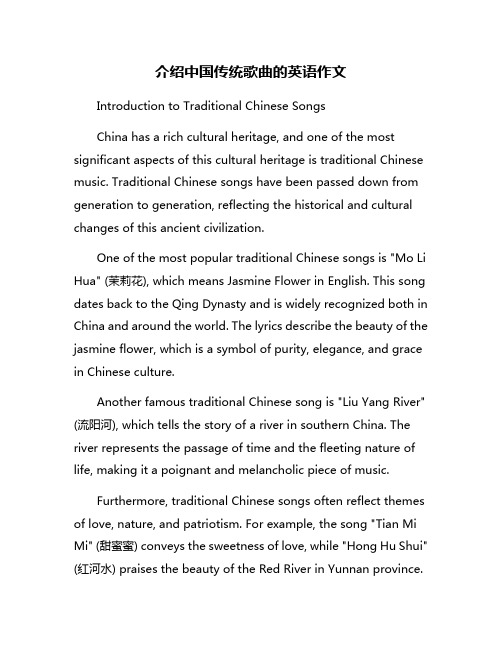
介绍中国传统歌曲的英语作文Introduction to Traditional Chinese SongsChina has a rich cultural heritage, and one of the most significant aspects of this cultural heritage is traditional Chinese music. Traditional Chinese songs have been passed down from generation to generation, reflecting the historical and cultural changes of this ancient civilization.One of the most popular traditional Chinese songs is "Mo Li Hua" (茉莉花), which means Jasmine Flower in English. This song dates back to the Qing Dynasty and is widely recognized both in China and around the world. The lyrics describe the beauty of the jasmine flower, which is a symbol of purity, elegance, and grace in Chinese culture.Another famous traditional Chinese song is "Liu Yang River" (流阳河), which tells the story of a river in southern China. The river represents the passage of time and the fleeting nature of life, making it a poignant and melancholic piece of music.Furthermore, traditional Chinese songs often reflect themes of love, nature, and patriotism. For example, the song "Tian Mi Mi" (甜蜜蜜) conveys the sweetness of love, while "Hong Hu Shui" (红河水) praises the beauty of the Red River in Yunnan province.In addition to vocal music, traditional Chinese songs also include instrumental pieces such as "Erhu" (二胡) and "Guzheng" (古筝) music. The erhu is a two-stringed instrument that produces soulful and haunting melodies, while the guzheng is a zither with a history dating back thousands of years.Overall, traditional Chinese songs are a valuable part of China's cultural heritage, conveying the emotions, stories, and aspirations of the Chinese people throughout history. By exploring and appreciating these songs, we can gain a deeper understanding of Chinese culture and traditions.。
古典音乐英文介绍作文
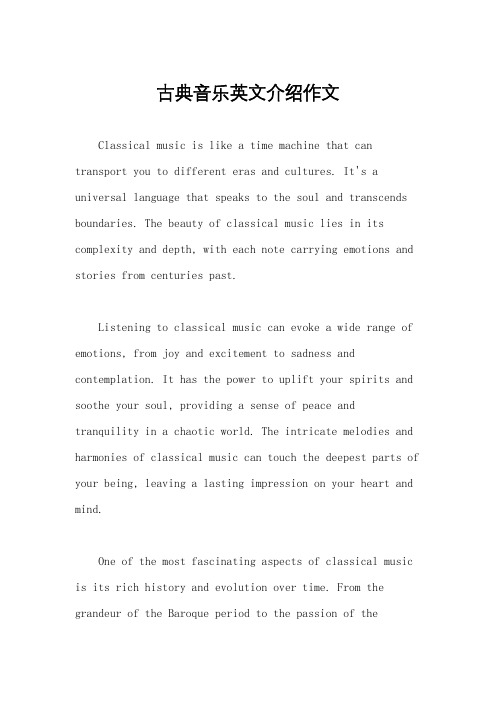
古典音乐英文介绍作文Classical music is like a time machine that can transport you to different eras and cultures. It's a universal language that speaks to the soul and transcends boundaries. The beauty of classical music lies in its complexity and depth, with each note carrying emotions and stories from centuries past.Listening to classical music can evoke a wide range of emotions, from joy and excitement to sadness and contemplation. It has the power to uplift your spirits and soothe your soul, providing a sense of peace andtranquility in a chaotic world. The intricate melodies and harmonies of classical music can touch the deepest parts of your being, leaving a lasting impression on your heart and mind.One of the most fascinating aspects of classical music is its rich history and evolution over time. From the grandeur of the Baroque period to the passion of theRomantic era, each period in classical music has its own unique style and characteristics. The works of famous composers like Bach, Mozart, Beethoven, and Chopin have stood the test of time, continuing to inspire and captivate audiences around the world.Attending a live classical music performance is a truly magical experience that can transport you to another world. The sight of talented musicians playing in perfect harmony, the sound of instruments resonating throughout the concert hall, and the feeling of being surrounded by fellow music lovers all come together to create a sense of unity and connection that is truly special.In conclusion, classical music is a timeless art form that has the power to move and inspire people of all ages and backgrounds. Whether you're a seasoned music lover or a newcomer to the world of classical music, there is something for everyone to appreciate and enjoy. So take a moment to sit back, relax, and let the beautiful melodies of classical music sweep you away on a journey of emotion and imagination.。
介绍古典乐的英语作文

介绍古典乐的英语作文Title: An Introduction to Classical Music。
Classical music is a genre that has stood the test of time, captivating audiences for centuries with its timeless beauty, complexity, and emotional depth. Originating in Western culture, classical music encompasses a vast array of styles, periods, and composers, each contributing to its rich tapestry of melodies and harmonies. In this essay, we will explore the essence of classical music, its history, prominent composers, and enduring legacy.The Essence of Classical Music:Classical music is characterized by its adherence to form, structure, and tradition. Unlike other genres that prioritize improvisation or experimentation, classical compositions are meticulously crafted, often following established musical forms such as sonata-allegro, rondo, or theme and variations. This attention to structure allowsfor the development of intricate musical ideas and themes, creating a sense of coherence and balance within the composition.Furthermore, classical music is renowned for its emotional depth and expressiveness. Composers harness the power of melody, harmony, and dynamics to evoke a wide range of emotions, from joy and exuberance to melancholy and introspection. Whether through the grandeur of a symphony or the intimacy of a solo piano piece, classical music has the ability to resonate with listeners on a profound level, transcending cultural and linguistic barriers.A Brief History of Classical Music:The history of classical music can be traced back to the medieval and Renaissance periods, with the emergence of sacred vocal music such as Gregorian chant and polyphony. However, it was during the Baroque era (1600-1750) that classical music truly flourished, with composers like Johann Sebastian Bach, George Frideric Handel, and AntonioVivaldi making significant contributions to the genre.The Classical era (1750-1820) saw further developments in musical form and style, with composers such as Wolfgang Amadeus Mozart, Ludwig van Beethoven, and Franz Joseph Haydn pushing the boundaries of musical expression. This period gave rise to the symphony, concerto, and sonata, as well as the establishment of the classical orchestra as we know it today.The Romantic era (c. 1820-1900) witnessed a surge in emotional intensity and individualism, with composers like Ludwig van Beethoven, Johannes Brahms, and Pyotr Ilyich Tchaikovsky imbuing their works with a sense of passion and drama. This period also saw the rise of program music, where composers sought to tell stories or evoke imagery through their compositions.The 20th century brought further innovation and experimentation to classical music, with composers such as Igor Stravinsky, Arnold Schoenberg, and Claude Debussy pushing the boundaries of tonality, form, andinstrumentation. This period saw the emergence of new musical movements such as impressionism, expressionism, and serialism, reflecting the rapidly changing cultural landscape of the time.Prominent Composers:Numerous composers have left an indelible mark on the world of classical music, each contributing to its rich legacy with their unique style and vision. Some of the most celebrated composers include:Johann Sebastian Bach: Renowned for his mastery of counterpoint and complex harmonic structures, Bach's music is revered for its intellectual depth and spiritual resonance.Wolfgang Amadeus Mozart: A child prodigy and prolific composer, Mozart's music embodies elegance, clarity, and emotional sensitivity, showcasing his unparalleled melodic gift and technical virtuosity.Ludwig van Beethoven: A revolutionary figure in classical music, Beethoven's compositions epitomize the struggle for individual expression and artistic freedom, transcending the conventions of his time with their boldness and innovation.Franz Schubert: Known for his lyrical melodies and poignant harmonies, Schubert's music exudes a sense of intimacy and emotional intimacy, exploring themes of love, loss, and longing with profound depth and sensitivity.Pyotr Ilyich Tchaikovsky: A master of orchestration and melody, Tchaikovsky's music is characterized by its lush Romanticism and vivid emotional imagery, capturing the essence of the human experience with its passion and intensity.The Enduring Legacy of Classical Music:Despite the passage of time, classical music continues to inspire and captivate audiences around the world, transcending cultural and generational boundaries with itstimeless beauty and universal themes. From concert halls to film scores, classical music remains a vital andinfluential force in contemporary culture, enriching our lives and stirring our souls with its boundless creativity and profound depth.In conclusion, classical music stands as a testament to the enduring power of human creativity and expression. Through its rich history, diverse repertoire, and profound emotional impact, classical music continues to resonate with audiences of all ages and backgrounds, reminding us of the beauty and complexity of the human experience.。
中国古典音乐 China classical music 英文介绍
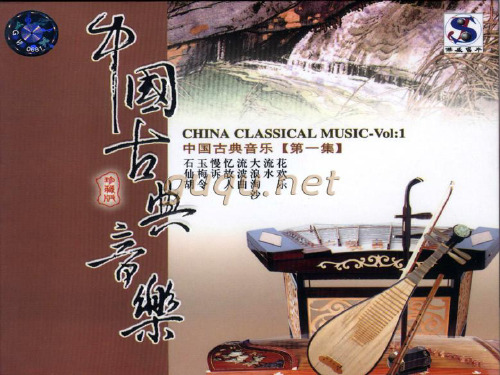
Dialog Between Fisherman
And Woodcutter
The Eighteen Beat of Wu Gier
A Music From Guangling
Sheng :made by reed and gourd
Xiao :made by bamboo
Chu
made
by wood
Xun
made by clay
黑陶埙
贝壳埙
Bell -
made by
metal
Sonorous stone –made by stone
Drum
– made
by skin
There is reed and gourd to make Sheng , bamboo to make Xiao(panpipes), wood to make Chu, silk to make Guzheng, clay to make Xun, metal to make Bell, stone to make Sonorous stone, and skin to make Drum .
宫商角徵羽
Pentatonic scale
Chinese music instruments can be categorized into eight classes by the materials they are made from. There are eight kinds of materials: metal , stone, clay, leather, silk, wood, bottle-gourd and bamboo .
High Mountains
And Flowing Streams
古典音乐介绍英语作文
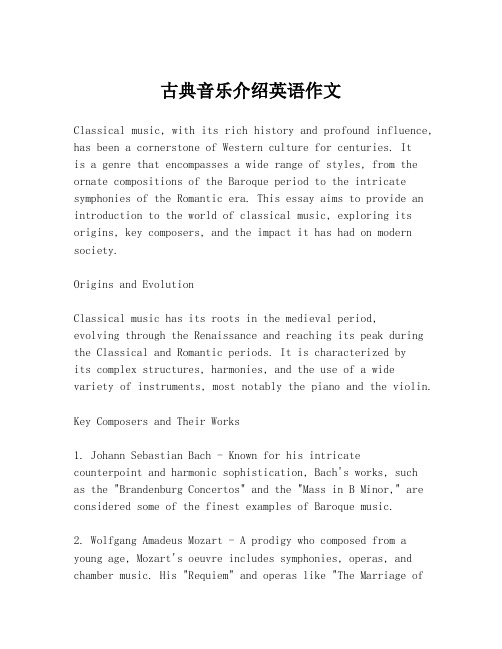
古典音乐介绍英语作文Classical music, with its rich history and profound influence, has been a cornerstone of Western culture for centuries. Itis a genre that encompasses a wide range of styles, from the ornate compositions of the Baroque period to the intricate symphonies of the Romantic era. This essay aims to provide an introduction to the world of classical music, exploring its origins, key composers, and the impact it has had on modern society.Origins and EvolutionClassical music has its roots in the medieval period,evolving through the Renaissance and reaching its peak during the Classical and Romantic periods. It is characterized byits complex structures, harmonies, and the use of a wide variety of instruments, most notably the piano and the violin.Key Composers and Their Works1. Johann Sebastian Bach - Known for his intricatecounterpoint and harmonic sophistication, Bach's works, suchas the "Brandenburg Concertos" and the "Mass in B Minor," are considered some of the finest examples of Baroque music.2. Wolfgang Amadeus Mozart - A prodigy who composed from a young age, Mozart's oeuvre includes symphonies, operas, and chamber music. His "Requiem" and operas like "The Marriage ofFigaro" are still performed worldwide.3. Ludwig van Beethoven - Beethoven's music marked a transition from the Classical to the Romantic period. His "Symphony No. 9" and "Moonlight Sonata" are iconic piecesthat continue to inspire musicians and listeners alike.4. Pyotr Ilyich Tchaikovsky - A leading composer of the Romantic period, Tchaikovsky's "Swan Lake" and "1812 Overture" are testaments to his emotive and expressive style.Instruments and OrchestrasThe classical music ensemble typically includes a range of string, woodwind, brass, and percussion instruments. The modern symphony orchestra, which can number over a hundred musicians, is the largest ensemble in the genre and is capable of producing a vast array of sounds and dynamics.Impact on Modern SocietyClassical music has permeated various aspects of modern culture. It is not only performed in concert halls but also featured in films, commercials, and even video games. The study of classical music has been shown to enhance cognitive abilities and is often included in educational curriculums.ConclusionClassical music is a testament to the human capacity for creativity and expression. It has the power to evoke deepemotions and has stood the test of time, remaining relevant and beloved by audiences around the world. As we continue to explore and appreciate this vast and diverse genre, we gain a deeper understanding of our cultural heritage and the universal language of music.。
古典乐介绍英文作文

古典乐介绍英文作文英文:Classical music is a genre of music that originated in Europe during the Classical period, which lasted from the mid-18th century to the early 19th century. It is characterized by its formal structure, use of orchestral instruments, and adherence to traditional musical forms such as sonata, symphony, and concerto.One of the most famous composers of classical music is Wolfgang Amadeus Mozart. His music is known for itsintricate melodies, harmonies, and use of counterpoint. Another well-known composer is Ludwig van Beethoven, whose music is characterized by its emotional intensity and use of unconventional harmonies.Classical music has had a significant influence on many other genres of music, including rock, jazz, and pop. For example, many rock bands have incorporated classicalelements into their music, such as the use of orchestral instruments or classical chord progressions.In addition to its musical influence, classical music also has a rich cultural history. Many famous classical works were commissioned by wealthy patrons, such as the Hapsburgs in Austria or the Medici family in Italy. These works were often performed at elaborate royal or aristocratic events, such as balls or operas.Overall, classical music is a genre that has stood the test of time and continues to inspire and influence musicians and music lovers around the world.中文:古典音乐是一种起源于欧洲的音乐流派,始于18世纪中期,持续到19世纪初。
介绍古典乐的英语作文
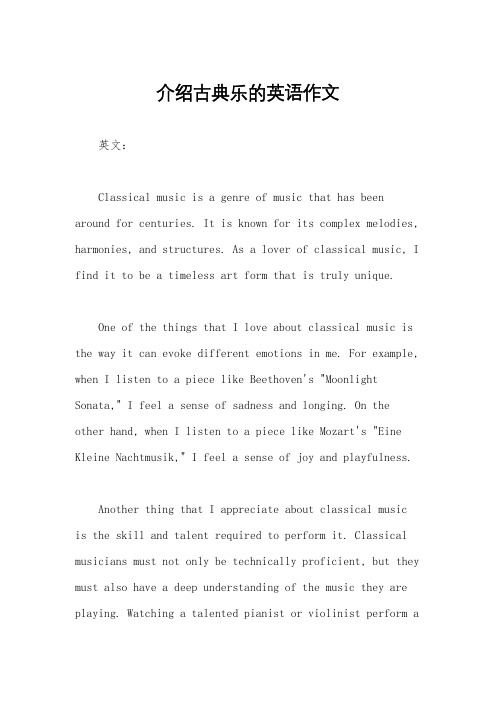
介绍古典乐的英语作文英文:Classical music is a genre of music that has been around for centuries. It is known for its complex melodies, harmonies, and structures. As a lover of classical music, I find it to be a timeless art form that is truly unique.One of the things that I love about classical music is the way it can evoke different emotions in me. For example, when I listen to a piece like Beethoven's "Moonlight Sonata," I feel a sense of sadness and longing. On the other hand, when I listen to a piece like Mozart's "Eine Kleine Nachtmusik," I feel a sense of joy and playfulness.Another thing that I appreciate about classical musicis the skill and talent required to perform it. Classical musicians must not only be technically proficient, but they must also have a deep understanding of the music they are playing. Watching a talented pianist or violinist perform adifficult piece is truly awe-inspiring.Finally, I think that classical music has a certain elegance and sophistication that is lacking in other genres of music. There is something special about listening to a symphony orchestra or a string quartet that cannot be replicated in other forms of music.中文:古典音乐是一种已经存在了几个世纪的音乐流派。
关于介绍中国民乐的英语作文

关于介绍中国民乐的英语作文Chinese traditional music, also known as Chinese folk music or Chinese classical music, has a history that dates back thousands of years. It is an integral part of Chinese culture and has greatly influenced music around the world.There are several types of Chinese traditional music, including classical music, folk music, and opera music. Classical music is often performed on traditional Chinese instruments such as the guqin, pipa, and erhu. These instruments have a unique sound and are often used to create beautiful and haunting melodies. Folk music, on the other hand, is more upbeat and lively, often featuring traditional Chinese instruments such as the dizi (flute) and suona (double-reed horn). Chinese opera music is another important genre, featuring a unique style of singing and storytelling.One of the most well-known forms of Chinese traditional music is the guqin music. The guqin is a seven-stringed instrument that has been played in China for over 3,000 years. It is often associated with scholars and intellectuals and is known for its deep, meditative sound.Guqin music is often used to create a sense of tranquility and contemplation.Another popular form of Chinese traditional music is the pipa music. The pipa is a four-stringed instrument that is played with a pick, creating a bright and lively sound. Pipa music is often used to accompany traditional Chinese dance and is known for its virtuosic and expressive performances.In addition to these traditional instruments, Chinese traditional music also includes a wide variety of percussion instruments such as drums, cymbals, and gongs. These instruments are often used to create a rhythmic and energetic sound that is characteristic of many forms of Chinese folk music.Chinese traditional music is often performed at traditional Chinese festivals and celebrations, as well as in concert halls and music venues around the world. It is a vibrant and diverse art form that continues to evolve and inspire musicians and audiences alike.中国传统音乐,又称中国民间音乐或中国古典音乐,历史可追溯数千年。
古典音乐英文介绍作文

古典音乐英文介绍作文英文:Classical music, also known as art music, is a genre of music that originated in Europe during the Classical period, which lasted from the mid-18th century to the early 19th century. It is characterized by its formal structure, useof orchestral instruments, and adherence to traditional musical forms such as the sonata, symphony, and concerto.One of the reasons I love classical music is itsability to evoke emotions and tell stories without the useof words. For example, Beethoven's Symphony No. 5 is a powerful piece that conveys a sense of struggle and triumph. The opening motif, consisting of three short notes followed by a long note, is instantly recognizable and has been used in popular culture to represent tension and suspense.Another reason I appreciate classical music is its timelessness. Even though some of these works were composedhundreds of years ago, they still resonate with audiences today. For instance, Bach's Goldberg Variations, written in the early 18th century, is still considered a masterpiece and is often performed by pianists around the world.In addition to its emotional and timeless qualities, classical music also has a rich history and culture surrounding it. From the courtly music of the Baroque erato the grand operas of the Romantic era, each period hasits own unique style and composers. Learning about the history and context of these works adds another layer of appreciation and understanding to the music.中文:古典音乐,也称为艺术音乐,是一种起源于欧洲的音乐流派,其发展始于18世纪中期,结束于19世纪初期。
介绍中国一首古典音乐英语作文

介绍中国一首古典音乐英语作文Classical Chinese music is a treasure trove of rich history and cultural heritage. One of the most renowned pieces is "High Mountain and Flowing Water," which has been passed down through generations, symbolizing the profound friendship between ancient Chinese musicians.This ancient melody is believed to have been composed during the Spring and Autumn period, around the 5th century BCE. It is a piece that is both complex and serene,reflecting the natural beauty of China's landscapes and the philosophical depth of its people.The composition is characterized by its use oftraditional Chinese instruments such as the guqin, a seven-stringed zither, which produces a sound that is both ethereal and grounding. The melody weaves through various movements, each with its unique mood and tempo, from the gentle flow of a stream to the majestic rise of a mountain peak."High Mountain and Flowing Water" is not just a piece of music; it is a narrative that speaks to the soul. It invites listeners to embark on a journey through the Chinese countryside, where one can almost hear the rustling of leaves and the whispering of the wind.The piece has been interpreted and performed by many musicians over the centuries, each bringing their own uniquetouch to the timeless classic. It stands as a testament tothe enduring appeal of traditional Chinese music and itsability to evoke emotions that transcend time and space.In modern times, this piece has been adapted into various forms, including orchestral arrangements and even electronic music, demonstrating its versatility and relevance in contemporary culture. Yet, at its core, "High Mountain and Flowing Water" remains a pure expression of the ancient Chinese spirit.For those seeking to understand the essence of Chinese classical music, "High Mountain and Flowing Water" is a must-listen. It offers a window into a world where nature, philosophy, and artistry converge to create a harmonious and profound listening experience.In conclusion, "High Mountain and Flowing Water" is more than just a melody; it is a cultural icon that encapsulatesthe essence of Chinese classical music. Its enduring legacy continues to inspire and captivate audiences around the world, serving as a bridge between the past and the present, and between cultures.。
古典音乐英文介绍作文初一

古典音乐英文介绍作文初一英文:Classical music is a genre of music that has been around for centuries and is known for its complexity, richness, and emotional depth. It is a genre that encompasses a wide range of styles and periods, from the Baroque and Classical eras to the Romantic and Modern periods.One of the things that I love about classical music is its ability to evoke strong emotions and tell stories without using words. For example, when I listen to Beethoven's Symphony No. 5, I can feel the intensity and passion in the music, even though there are no lyrics. The music speaks for itself and can convey a wide range of emotions, from joy and excitement to sadness and longing.Another aspect of classical music that I find fascinating is the skill and talent required to perform it.Many classical pieces are incredibly challenging to play, requiring a high level of technical proficiency and musicality. For instance, when I watch a pianist perform Chopin's Ballade No. 1, I am in awe of their dexterity and expressiveness as they navigate the intricate passages and bring the music to life.中文:古典音乐是一种有着几个世纪历史的音乐类型,以其复杂性、丰富性和情感深度而闻名。
古典音乐英文介绍作文高中
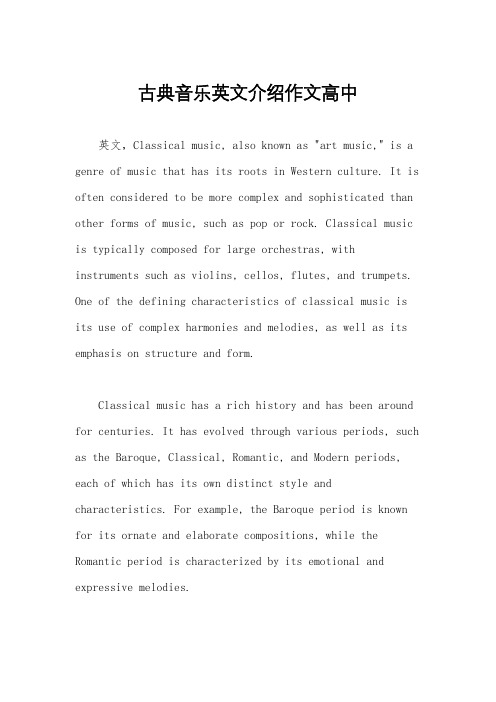
古典音乐英文介绍作文高中英文,Classical music, also known as "art music," is a genre of music that has its roots in Western culture. It is often considered to be more complex and sophisticated than other forms of music, such as pop or rock. Classical music is typically composed for large orchestras, with instruments such as violins, cellos, flutes, and trumpets. One of the defining characteristics of classical music is its use of complex harmonies and melodies, as well as its emphasis on structure and form.Classical music has a rich history and has been around for centuries. It has evolved through various periods, such as the Baroque, Classical, Romantic, and Modern periods, each of which has its own distinct style and characteristics. For example, the Baroque period is known for its ornate and elaborate compositions, while the Romantic period is characterized by its emotional and expressive melodies.One of the most famous classical composers is Ludwig van Beethoven, who is known for his powerful and emotional compositions. His Symphony No. 9, also known as the "Choral Symphony," is a prime example of the grandeur and complexity of classical music. Another iconic composer is Wolfgang Amadeus Mozart, whose compositions are known for their elegance and beauty.In addition to orchestral music, classical music also includes solo and chamber music, such as piano sonatas and string quartets. These smaller ensembles allow for more intimate and nuanced performances, showcasing the technical skill and artistry of the musicians.Classical music has had a significant influence on modern music and continues to be appreciated by audiences around the world. Its timeless beauty and complexity have made it a beloved genre for music enthusiasts and performers alike.中文,古典音乐,也被称为“艺术音乐”,是一种源自西方文化的音乐流派。
